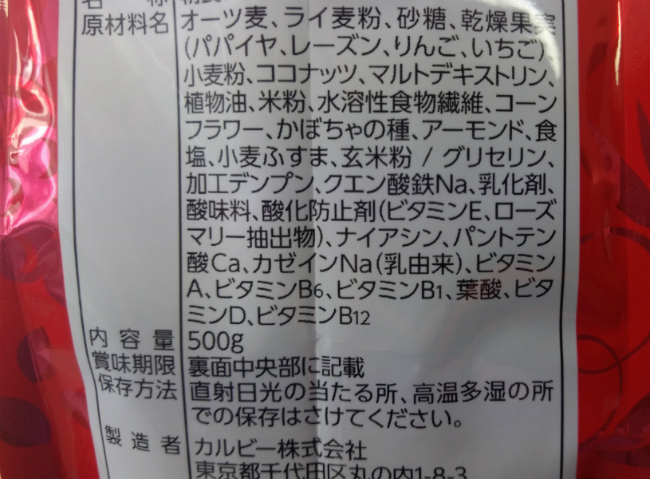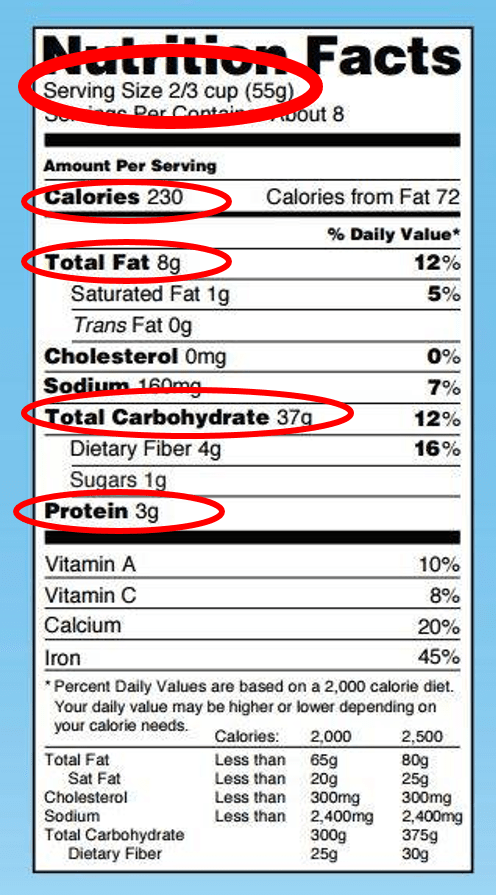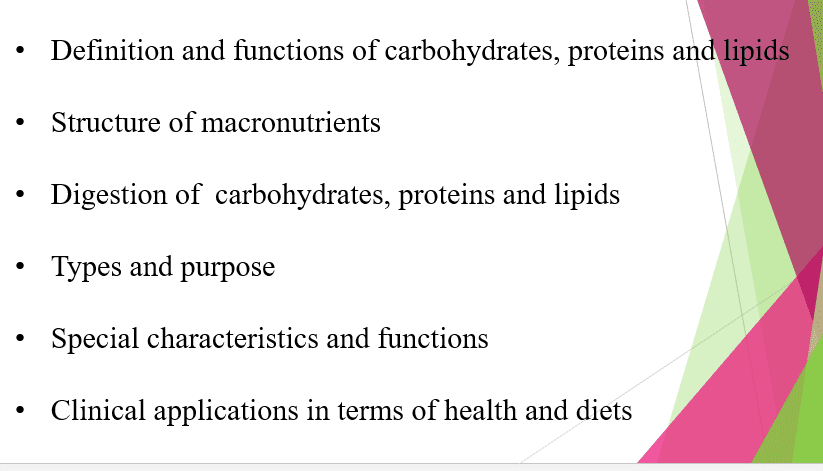45 macronutrients on food labels
Nutrient Claims on Food Labels - Clemson University They can be labeled "healthy" even if they don't have at least 10% DV per serving of the above nutrients. Meal-type products (e.g., frozen entrees and multi-course frozen dinners) must provide 10% DV of two or three of these: vitamins A or C, iron, calcium, protein, or fiber, as well as meet the other criteria. 1.2.1. Learning From Food Labels - Fundamentals of Health and Physical ... The Acceptable Macronutrient Distribution Range (AMDR) is the calculated range of how much energy from carbohydrates, fats, and protein is recommended for a healthy diet adequate of the essential nutrients and is associated with a reduced risk of chronic disease.
How to Understand and Use the Nutrition Facts Label | FDA - U.S. Food ... Dietary fiber, vitamin D, calcium, iron ad potassium are nutrients on the label that Americans generally do not get the recommended amount of. They are identified as nutrients to get more of....

Macronutrients on food labels
How Do I Determine the Macronutrient Content of Fresh Foods? - Healthline A 1/2 cup (90 grams or 119 ml) of fresh fruit or fruit juice, or a 1/4 cup (50 grams) of dried fruit, contains 15 grams of carbs, 0 grams of protein, and 0 grams of fat. Milk. One cup (237 ml) of... The Science Behind Calories and Nutrition Facts Labels These main nutrients are fats ( lipids ), proteins and carbohydrates. Some calories you consume every day should come from each of the three nutrients. About 50 to 60% of your calories should come from carbohydrates, 30% of your calories should come from fat and 12 to 20% of your calories should come from proteins (©2020 Let's Talk Science). NCDA&CS - Kid's World - Understanding Food Labels Fat, saturated fat, cholesterol, total carbohydrate, fiber, sugars, protein, vitamins A and C, calcium and iron are required on the label. Other nutrients may be listed if the company would like to list them. Nutrients are substances found in food that are needed for good health. Your body can't make nutrients, so they must be supplied by food.
Macronutrients on food labels. Daily Value on the New Nutrition and Supplement Facts Labels For the nutrients with DVs that are going up, the %DVs may go down. For example, the DV for total fat has been updated from 65g to 78g. That means that a packaged food with 36g of total fat in one ... Food Labels | CDC - Centers for Disease Control and Prevention If you eat the whole thing, you are eating 8 times the amount of calories, carbs, fat, etc., shown on the label. Total Carbohydrate shows you types of carbs in the food, including sugar and fiber. Choose foods with more fiber, vitamins, and minerals. Choose foods with lower calories, saturated fat, sodium, and added sugars. Macronutrients_Micronutrients_Food_Labels.pdf - THE... Nutrition information is available for many types of foods. Nutrition Facts labels are one source of this information. These labels contain information about the amounts of macronutrients and micronutrients in foods. For example, look at the Nutrition Fact Label for roasted peanuts and a medium-size apple on the following page. Notice that this label contains the following information. 5 Understanding Food Labels and Health Claims - Maricopa This label is called a Nutrition Facts panel, which gives information on the number of servings per container, the number of calories per serving, and certain nutrients. Specifically, it lists the macronutrients and four of the most important micronutrients people need to pay special attention to, such as Vitamin D, Calcium, Iron, and potassium.
What Are Macronutrients and How to Count Macros - Food Network Food Labels: 60% Carbs, 30% Fat, 10% Protein Food label "Daily Value" amounts are set by the FDA and based on a 2,000 calorie diet, which is not appropriate for everyone. These macro values may be... How to Read a Nutrition Label — and Finally Get Your Macros Right All whole foods provide a mixture of macronutrients (also known as macros) and micronutrients — which you'll see on a nutrition label. Advertisement As their respective names state, macronutrients are the nutrients that our bodies need in large amounts and are made up of: Fats Carbohydrates (including fiber and sugar) Proteins Glycemic index is as reliable as macronutrients on food labels Glycemic index is as reliable as macronutrients on food labels. Am J Clin Nutr. 2017 Mar;105 (3):768-769. doi: 10.3945/ajcn.116.146092. (PDF) Macronutrients compliance between foods labels and marketing ... Macronutrients compliance between foods labels and marketing package content values Authors: Yahya Pasdar Kermanshah University of Medical Sciences Mitra Darbandi Kermanshah University of Medical...
This Is How to Read a Nutrition Facts Label on the Keto Diet To go a little deeper, each of the three macronutrients (protein, carbohydrates, and fat) contains a certain amount of calories per gram, no matter what food they're in. For instance [ * ]: 1 gram of protein = 4 calories (4 units of energy) 1 gram of carbohydrate = 4 calories (4 units of energy) 1 gram of fat = 9 calories (9 units of energy) Food labels - NHS This type of label includes information on energy (kJ/kcal), fat, saturates (saturated fat), carbohydrate, sugars, protein and salt. It may also provide additional information on certain nutrients, such as fibre. All nutrition information is provided per 100 grams and sometimes per portion. How To Read Food and Beverage Labels - National Institute on Aging At the top of the Nutrition Facts label, you will find the total number of servings in the container and the food or beverage's serving size. The serving size on the label is based on the amount of food that people may typically eat at one time and is not a recommendation of how much to eat. Read more about serving and portion sizes. Understanding Food Labels and Nutrition - San-J Some of these components help the body activate macronutrients. You'll find examples of micronutrients like B vitamins, Vitamin D, iron, potassium and calcium towards the bottom of the nutrition label, along with their daily value percentages. What About Dietary Fiber? Fiber is a variety of carbohydrate and has two types.
How to Read a Nutrition Label For Macros | POPSUGAR Fitness For macros, he broke down how many calories per gram of fat (10 calories per gram), carbs (four calories per gram), and protein (four calories per gram) there are. These numbers will add up to the...
The Ultimate Guide To Macronutrients: Understanding ... - Swolverine Macronutrients (or macros for short) are the specific molecules that contain energy and nutrients to make up calories. Every calorie of food that you eat can be broken down into three main groups that contain energy (aka calories). Carbohydrates (1g carb = 4 calories) Protein (1g Protein = 4 calories) Fats (1g Fat = 9 calories)
Macromolecules, macronutrients - how are they digested? Macronutrients are the essential molecules that provide dietary energy to the body. They can be broken down into the following three nutrients. Carbohydrate Starch and sugars fall into the category of carbohydrates. Starch and sugars are made up of building blocks called monosaccharides (a monosaccharide is typically a single sugar unit).
How Do You Know Your Food's Nutrition Facts Label Is Accurate? NIST's measurements are accurate to within 2% to 5% for nutrient elements (such as sodium, calcium and potassium), macronutrients (fats, proteins and carbohydrates), amino acids and fatty acids. As you may have noticed, most of your favorite food items have recently updated their nutrition facts labels.
Food Labels | Nutrition - Lumen Learning Food Labels. In the United States, the Food and Drug Administration (FDA) requires packaged foods to have a label that helps consumers make educated decisions about the foods they purchase. The label provides caloric, macronutrient, and some micronutrient content of the food. Labels also indicate ingredients and manufacturer information.
Macro Math Is Hard: Understanding Nutrition Labels & Calculating Macros ... Step 3: Calculate your MacroNutrients Once you understand how to read a label and have tools to measure the food, you can figure out how much protein, carbs, & fat (macros) you have present. Let's say you need 25 grams of carbs for your meal and you want to get it from the whole-grain pasta. Here's the label again.
Nutrition Facts Labeling — FDA Reader Vitamins, Minerals and Macronutrients. The following vitamins and minerals are required on the nutritional label "Supplemental Facts" section. They must be measured in terms of percentage of daily value and weight. The minimum requirement is listed below (must be listed in this order): Vitamin D, Calcium. Iron.
Macronutrients: A Simple Guide to Macros - Avita Health System There are three types of macronutrients: carbohydrates, proteins, and fats. Carbohydrates contain 4 kcal per gram. Proteins contain 4 kcal per gram. Fats contain 9 kcal per gram (this is roughly double the amount found in the other two macros) Along with energy, all of these macronutrients have specific roles in your body that allows you to ...

How to Track Macronutrients - The Definitive Step by Step Guide | Hydration Monitoring - Intake ...
How To Read The Food Labels for Weight Loss It is important to measure out the correct portion of this food if your goal is weight loss. The serving size number you are looking for is located at the VERY TOP of the entire food label! This number is at the top for a reason: The nutritional information on the rest of the label applies to ONLY one serving. The FDA sets serving sizes for all ...
What Are Macronutrients? All You Need to Know - Healthline Macronutrients include carbs, protein, and fat. They provide energy in the form of calories and are needed to maintain your body's functions and structure. Food sources of carbs, protein, and fat...
NCDA&CS - Kid's World - Understanding Food Labels Fat, saturated fat, cholesterol, total carbohydrate, fiber, sugars, protein, vitamins A and C, calcium and iron are required on the label. Other nutrients may be listed if the company would like to list them. Nutrients are substances found in food that are needed for good health. Your body can't make nutrients, so they must be supplied by food.
The Science Behind Calories and Nutrition Facts Labels These main nutrients are fats ( lipids ), proteins and carbohydrates. Some calories you consume every day should come from each of the three nutrients. About 50 to 60% of your calories should come from carbohydrates, 30% of your calories should come from fat and 12 to 20% of your calories should come from proteins (©2020 Let's Talk Science).
How Do I Determine the Macronutrient Content of Fresh Foods? - Healthline A 1/2 cup (90 grams or 119 ml) of fresh fruit or fruit juice, or a 1/4 cup (50 grams) of dried fruit, contains 15 grams of carbs, 0 grams of protein, and 0 grams of fat. Milk. One cup (237 ml) of...
















Post a Comment for "45 macronutrients on food labels"